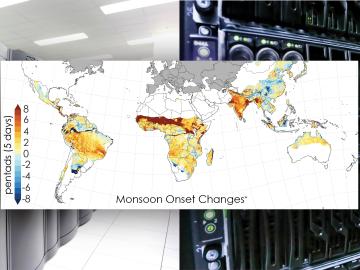
Filter News
Area of Research
- Advanced Manufacturing (2)
- Biology and Environment (5)
- Computer Science (1)
- Energy Science (19)
- Fusion and Fission (2)
- Fusion Energy (2)
- Isotopes (1)
- Materials (11)
- Materials for Computing (1)
- National Security (6)
- Neutron Science (4)
- Nuclear Science and Technology (8)
- Nuclear Systems Modeling, Simulation and Validation (1)
- Supercomputing (11)
News Type
News Topics
- (-) Artificial Intelligence (4)
- (-) Big Data (3)
- (-) Cybersecurity (1)
- (-) Environment (18)
- (-) Grid (5)
- (-) Machine Learning (6)
- (-) Microscopy (6)
- (-) National Security (2)
- (-) Nuclear Energy (16)
- (-) Security (2)
- 3-D Printing/Advanced Manufacturing (17)
- Advanced Reactors (9)
- Bioenergy (7)
- Biology (4)
- Biomedical (14)
- Biotechnology (1)
- Buildings (1)
- Chemical Sciences (5)
- Composites (1)
- Computer Science (21)
- Coronavirus (16)
- Critical Materials (2)
- Energy Storage (16)
- Exascale Computing (1)
- Frontier (1)
- Fusion (6)
- High-Performance Computing (2)
- Isotopes (6)
- Materials (2)
- Materials Science (26)
- Mathematics (1)
- Molten Salt (2)
- Nanotechnology (14)
- Neutron Science (21)
- Physics (12)
- Polymers (6)
- Quantum Science (6)
- Space Exploration (1)
- Summit (12)
- Transportation (9)
Media Contacts

Scientists from the Department of Energy’s Oak Ridge National Laboratory and a dozen other international research institutions have produced the most elaborate set of projections to date that illustrates possible futures for major monsoon regions.

In the search to create materials that can withstand extreme radiation, Yanwen Zhang, a researcher at the Department of Energy’s Oak Ridge National Laboratory, says that materials scientists must think outside the box.

Juergen Rapp, a distinguished R&D staff scientist in ORNL’s Fusion Energy Division in the Nuclear Science and Engineering Directorate, has been named a fellow of the American Nuclear Society

A multi-institutional research team found that changing environmental conditions are affecting forests around the globe, leading to increasing tree death and uncertainty about the ability of forests to recover.

Scientists have tapped the immense power of the Summit supercomputer at Oak Ridge National Laboratory to comb through millions of medical journal articles to identify potential vaccines, drugs and effective measures that could suppress or stop the
An international team of scientists found that rules governing plant growth hold true even at the edges of the world in the Arctic tundra.

For the second year in a row, a team from the Department of Energy’s Oak Ridge and Los Alamos national laboratories led a demonstration hosted by EPB, a community-based utility and telecommunications company serving Chattanooga, Tennessee.

Researchers at the Department of Energy’s Oak Ridge National Laboratory are refining their design of a 3D-printed nuclear reactor core, scaling up the additive manufacturing process necessary to build it, and developing methods

Researchers at Oak Ridge National Laboratory demonstrated a 20-kilowatt bi-directional wireless charging system on a UPS plug-in hybrid electric delivery truck, advancing the technology to a larger class of vehicles and enabling a new energy storage method for fleet owners and their facilities.

In the 1960s, Oak Ridge National Laboratory's four-year Molten Salt Reactor Experiment tested the viability of liquid fuel reactors for commercial power generation. Results from that historic experiment recently became the basis for the first-ever molten salt reactor benchmark.


